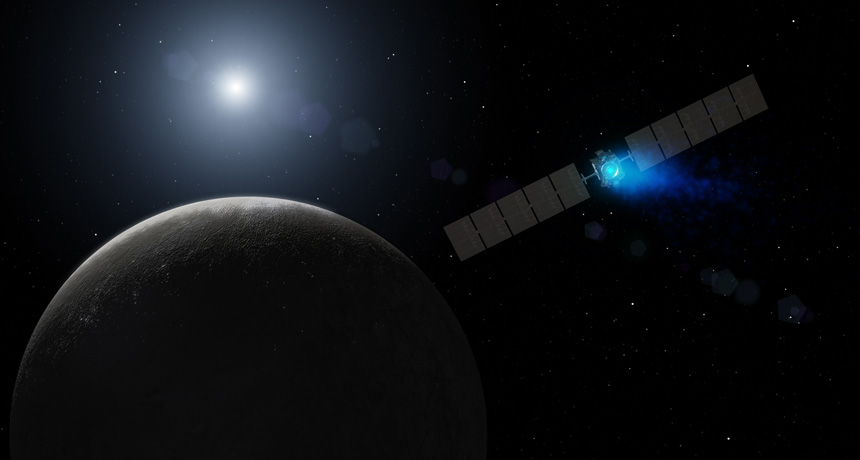Dawn spacecraft arrives at dwarf planet Ceres
Probe will start investigation of the early solar system

HOME STRETCH The Dawn spacecraft has arrived at Ceres, shown in an artist’s illustration, to begin a 14-month investigation of the dwarf planet.
JPL-Caltech/NASA
- More than 2 years ago
The Dawn spacecraft has arrived at the dwarf planet Ceres.
After 7½ years trekking across the solar system — including a stopover at the asteroid Vesta — Dawn pulled up alongside Ceres March 6 and let the dwarf planet’s gravity take over, pulling the probe in for a closer look. In six more weeks, Dawn will be close enough to Ceres to begin its 14-month mission to map the dwarf planet in a quest for clues about the formation of the solar system.
Dawn is about “going back in time and visiting the basic remnants of objects that came together to form our planets,” Jim Green, director of NASA’s Planetary Science Division, said March 2 at a news conference.
Researchers believe that Ceres is an intact protoplanet, a fossil from the beginning of the solar system. About 2.8 times as far from the sun as Earth, Ceres is roughly as wide as France, making it the largest body in the asteroid belt between Mars and Jupiter. Starting in late April, Dawn will make detailed maps of Ceres, studying its size, shape and composition.
Unlike other solar system missions (SN: 9/6/14, p. 8), Dawn’s arrival is a bit anticlimactic. “There’s literally nothing to watch at the time it happens,” said Robert Mase, project manager for the Dawn mission at the Jet Propulsion Laboratory in Pasadena, Calif. The spacecraft is approaching Ceres from the night side and won’t take any images until after it loops over the north pole in late April. “Then the floodgates are really going to open,” Mase said.
Dawn has already turned up some surprises. A bright spot first reported in 2005 from Hubble Space Telescope images is actually two spots nestled inside a crater (SN Online: 2/26/15). These spots “have been puzzling to the team,” said Carol Raymond, deputy project scientist at JPL. “Their apparent brightness is off the scale.” The spots are probably patches of ice either excavated by asteroid impacts or blown out of cryovolcanoes. But the team won’t know more until Dawn gets closer in.
“It seems to be off to a really good start,” says Peter Thomas, a planetary scientist at Cornell University who is not a member of the Dawn team. “The more fun thing is trying to figure out what’s on the inside (of Ceres) and what the role of water has been.” Researchers suspect that a global ice sheet lurks beneath the rocky crust, possibly a remnant of a subsurface ocean (SN Online: 1/22/14). Dawn will look for evidence of material on the surface that originated in interactions between liquid water and rock.
The seas of Ceres might have even once been habitable, Raymond said.
This is the second stop for Dawn, which spent 14 months in 2011 and 2012 orbiting the asteroid Vesta (SN: 4/21/12, p. 9). Dawn found dark patches loaded with carbon-rich elements, said Raymond, which the team suspects arrived via water-rich asteroids that were similar to Ceres. If these asteroids delivered water and other goodies to Vesta, they also probably delivered material to the inner rocky planets, providing a possible link between Ceres, Vesta and Earth’s oceans.
“We’ll get some answers right away,” Green said, “but it will take years to figure out the puzzle of how Ceres and Vesta fit into the building blocks of our solar system.”







